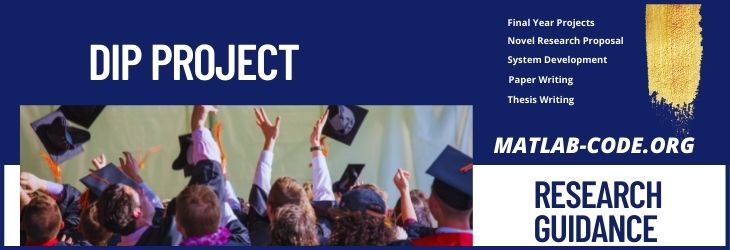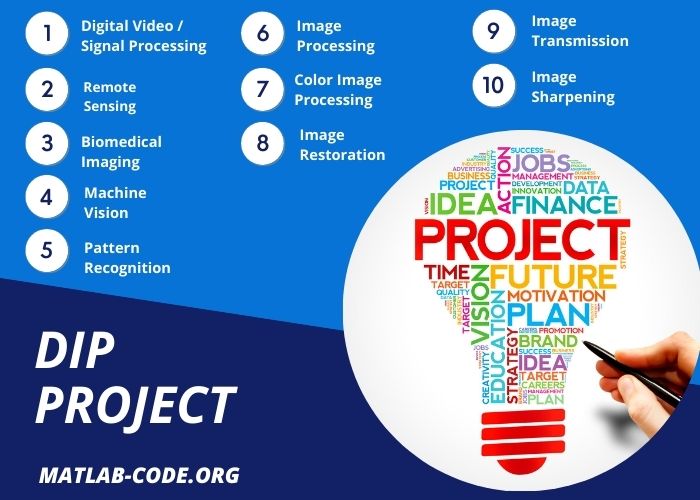Digital image processing (DIP) is subject to the algorithms and techniques to produce the enhanced digital images. Doing Project DIP enables the scholar or developer to do any sort of process like extracting, reading, restoring, enhancing, analyzing, and acquiring detailed feature information of an image.
In this article, you can grasp important research information on the digital image processing domain!!!
In general, project DIP undergoes three phases of operations such as importing the image, analyzing/manipulating the image, and generating the output. Further, it split up into two branches, such as analog and digital image processing where currently digital type is widely extents in many research areas real-time applications and projects in DIP. Next, we can see the essential features that influence digital image processing matlab projects to create the best DIP research.
Key Advantages of Digital Image Processing
- Free from minor errors
- Automate the processing techniques of digital images through digital systems
- Automated image organization based on contents
- Easy to predict the changing weather condition
- Quick image compression and decompression
- Visualize the invisible or unrecognized features
- Better visual interpretation through image sharpness technique
- Effortlessly change the size and resolution of image
- Assurance of images smoothness
- Allow to investigate the bio-medical images (cells with their composition)
- Unchallenging to take out imperfect products from the manufacture line
- Easy to extract the edge to analyze the boundaries and other vital features which is used in industry
In order to achieve the quality of the enhanced image, the best Project DIP needs to undergo several advanced image processing methodologies. For your reference, our developers have itemized some ground-breaking techniques that play a major role in obtaining accurate results.
Digital Image Processing Techniques
- Pixelation – Break the image into individual pixels (i.e., digital form)
- Image Editing – Modify the images through specially designedgraphics enabled software tools
- Hidden Markov Models – Analyze the 2D image by verifying the probability of sequence (depends on internal features)
- Independent Component Analysis – Bring out the hidden elements that splits the independent source / variables from mixed signals
- Principal Components Analysis – Extract the feature by analyzing principal component of the image and also called dimension reduction method
- Anisotropic Diffusion – Take out the noise from an image without affecting the other significant portions which is also called as Perona-Malik Diffusion
- Image Restoration – Remove the corrupted portion of image and recover the original image without the dropping the content
- Partial Differential Equations – De-noise the image by analyzing the relation of independent variables
- Linear Filtering. Produce the output signal that vary linearly to the time-varying input signals
- Neural Networks – Part of the machine learning algorithmsto perform various image processes like recognition, segmentation, classification, etc.
- Self-organizing Maps – Categorizing the images into multiple classes
- Wavelets – Mathematical method to compress image, reduce noise, reconstruct signal, and many more
Further, we have given the greatest result-yielding algorithms for enhancing image quality in digital image processing projects. The below approaches efficiently analyze the image and improve the invisible or uncertain image contents before processing the image project dip.

Algorithms Image Enhancement
- DCP along with Median Filter
- RGB CLAHE and HSV Fusion
- Dual Mode Dynamics Neural Network (D2NN)
- Dark and Bright Channel Prior (DCP / BCP)
- Single-scale and Multi-scale Retinex Model
- Bilateral Filter based Social Spider Optimization (SSO)
- Lightweight Graph based Relational Learning Approach
- Supervised, Semi-Supervised and Self-Supervised GAN
- Gray World White Balancing and Color Balancing with Multi-Scale Fusion
Next, we can see about the preprocessing techniques that eliminate unwanted or noises in the image, which restrict to attain enhanced image quality. It compares with neighboring pixels for contrast adjustments, redundancy removal, intensity adjustment, etc.
Image Preprocessing Methods
Optimization Techniques
- Harris Hawks
- Artificial Bee Colony (ABC)
- Spiral Dynamics Inspired Optimization
- Emperor Penguins Colony (EPC)
- Ant Colony Optimization (ACO)
- Killer Whale Optimization (KWO)
- Hydrological / Water Cycle Algorithm (HCA / WCA)
- Particle Swarm Optimization (PSO) and Enriched–PSO
- And also many more
Filtering Techniques
- Adaptive Median and Mean
- Gabor and Gaussian
- Unilateral / Bilateral Laplacian
- Low Pass and High Pass
- Adaptive Alpha Trimmed Mean
Here, our resource team has given some important research areas that currently many researchers are looking for. These evergreen areas surely support you in future studies and developments by continuing the current research to the next advancements and sharpening your skills in project dip.
What are the Areas of Image Processing?
- Digital Video / Signal Processing
- Image Sharpening
- Remote Sensing
- Image Restoration
- Color Image Processing
- Biomedical Imaging
- Image Enhancement
- Robot or Machine Vision
- Image Transmission (encode and decode)
- Pattern Recognition
- Image Feature Extraction and Selection
- Image Processing (Segmentation, Classification)
- Image Compression and Decompression
More than this, several research ideas include biomedical imaging, object detection, image acquisition from the database, facial expression recognition, geospatial map generation, and agricultural and urban region classification developed for project dip.
DIP Project Topics
- Video Processing
- The quick movement of digital images is collectively called as video. Also, video processing is the part of the signal / image processing
- No. of. Frames / pictures transmitted per minute and each frame quality define the video quality
- For instance: noise / motion reduction, aspect ratio conversion, detail enrichment, color space conversion, frame rate conversion, etc.
- Pattern Recognition
- It classify the object based on the given pattern using ML algorithms
- By the by, it extracts the object / feature from image and train them using ML for pattern changing and analysis
- For example: Handwriting recognition, Face recognition and Computer-aided diagnosis
- Color Processing
- It performs on dissimilar color spaces and colored images for identifying and extracting specific object
- Further, it also support storage, transmit, encode and decode of color images
- For instance: HSV, YCbCr, and RGB color
When you choose the medical thesis topic, you can choose either the latest problem or a problem that has not effectively been solved yet. Once you select the topic, then make clear with scope of the problem and a summary of the plan to report to others. Next, select the appropriate tool that fits your research need. Our developers have given you a few noteworthy Project DIP development toolboxes for your ease.

Matlab Toolboxes for DIP
- Neural Network Toolbox
- Inclusive collection of pre-trained algorithms, models, apps to create, test and simulate neural network application in MATLAB
- MATLAB
- Sophisticated responsive environs for performing numeric computation, innovative graphics, matrix functions, graph plotting, algorithm design and visualization through high-level language
- Mapping Toolbox
- Contains functions to design the map and analyze geospatial information
- Statistics Toolbox
- Give comprehensive libraries for analyzing modeling system and historical data
- Also, it supports development of teaching statistics, learning and statistical algorithms
- Optimization Toolbox
- Provide platform to optimize large-scale tasks (linear, nonlinear, quadric problems). Also, it perform the parameter alteration and assessment
- Wavelet Toolbox
- Bestowed with methods to analyze continuous signal/image, compression, denoising, many more
- Fuzzy Logic Toolbox
- Furnished with MATLAB tools, packages, simulink tool to design the complex system through simple fuzzy logics
- Signal Processing Toolbox
- Afford a podium to model the linear, time-series data and signal system. Also, it supports from wavelet transformation to algorithm development
Performance Analysis for Project DIP
Tracking of experiments helps you examine the worth of the executed experiments and also help to improve the experiment results in different aspects. So, here we have listed out little information to monitor the experiments for the benefit of metadata,
- Configuration Parameters
- Model Weights
- Customizable Environment Configuration Files
- Performance Evaluation Metrics
- Experiment Scripts
- Dataset Versions (for training, testing and assessment)
- Performance visualizations charts (for classification: ROC curve and confusion matrix)
For better understanding, our experts have listed out some checkpoints that you should follow analysing the experiments. This will surely showcase the performance ability of the developed system.
How to perform Experiment Analysis?
- Learn and understand the overlapping curves
- Relate the experiments others based on parametric and non-parametric values
- Do the comparative analysis through performance parameters
- Check over the hardware utilization while execution and estimation such as Lime, SHAP and Feature
- Estimate the worst and best aspects on validation and test sets
- Relate rich-format artifacts (audio / video) for qualitative research
- Compare the classifiers through performance charts (ROC Curve, Confusion Matrices and more)
Example predictions on the validation set (common in computer vision)
As a matter of fact, it is essential to validate the conducted experiments to track the existence of the inconvenience. This will surely help you to tackle the problems in handling metadata systems. Usually, these kinds of systems have following three important entities,
- Experiment Dataset / Database: Store the experiment metadata for querying and logging
- Set of Library: Includes functions for querying and logging data from metadata
- Experiment Dashboard: Display the experiment metadata in interface
On the whole, we are glad to inform you that we are ready to help you in project dip for your whole research journey at your needy time.





